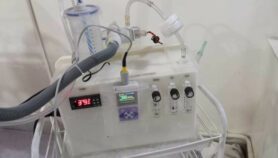By: James Njoroge
Send to a friend
The details you provide on this page will not be used to send unsolicited email, and will not be sold to a 3rd party. See privacy policy.
A group of researchers has published controversial research findings that, they claim, indicate that exposure to unsafe health care — rather than sexual interaction — appears to be the main mode of HIV transmission in adults in Africa.
The authors of a series of scientific articles, which will appear in next month’s issue of the International Journal of STD & AIDS, question the widely held view that heterosexual transmission accounts for 90 per cent of HIV infections in African adults, saying that it is a hypothetical figure.
In one paper, US consultants David Gisselquist and John J Potterat say that researchers who have accepted this assumption “have typically studied risk factors for HIV in African adults without collecting or reporting information essential to test this estimate.”
But many others are sceptical of their conclusions, and concerned about their impact. In an interview with the BBC, Catherine Hankins, chief scientific adviser for UNAIDS, cautions that “a report like this might tend to make people drop their guard and not use condoms, when it is exactly using condoms that is required at this point.”
And Christopher Uoma, HIV co-ordinator for ActionAid in Kenya, warned that the researchers’ claims could make people who needed treatment reluctant to enter hospitals.
The researchers argue that their new estimates, which are based on epidemiological records from 1984 to 1988, show that heterosexual transmission accounts for only between 25 and 35 per cent of HIV incidence in Africa.
In contrast, they say, health care exposures caused more HIV than sexual transmission, with contaminated medical injections being the biggest risk. For example, they point out that South Africa and Zimbabwe, which both have a well-established health care infrastructure, have reported unprecedented increases in HIV/AIDS cases.
“High rates of HIV in South Africa have paralleled aggressive efforts to deliver health care to rural populations,” the researchers argue.
The authors of the papers say the scheme to present AIDS in Africa as a heterosexual epidemic was hatched by researchers in developed countries in order to secure media attention. “Nothing captured the attention of editors and news directors like the talk of widespread heterosexual transmission of AIDS,” they say.
They also warn that further delay in reopening the mid-1980s debate about the relative proportion of African HIV from sexual and health care exposures could have serious consequences on African and Asian countries with burgeoning HIV epidemics.
But their findings came under widespread criticism shortly after they had been made public. One AIDS researcher, George Shmid, told the UN’s IRIN news service that only about 2.5 per cent of new infections were attributable to unsafe medical care and injections in Africa (although the global figure is estimated by the World Health Organisation to be 5 per cent).
Debbie Bradshaw, a research director at South Africa’s Medical Research Council, told the same news service that the claims made by the researchers reflected “an important issue that should not be ignored, but the extent of it has been over-represented”.
Related external links:
International Journal of STD & AIDS press release
World Health Organisation













